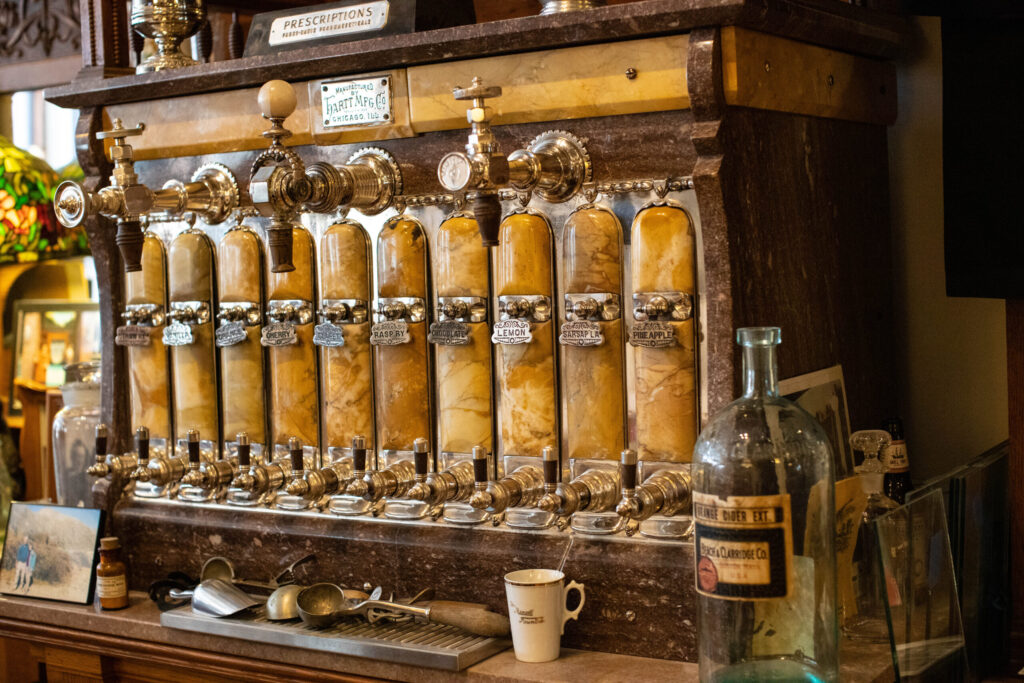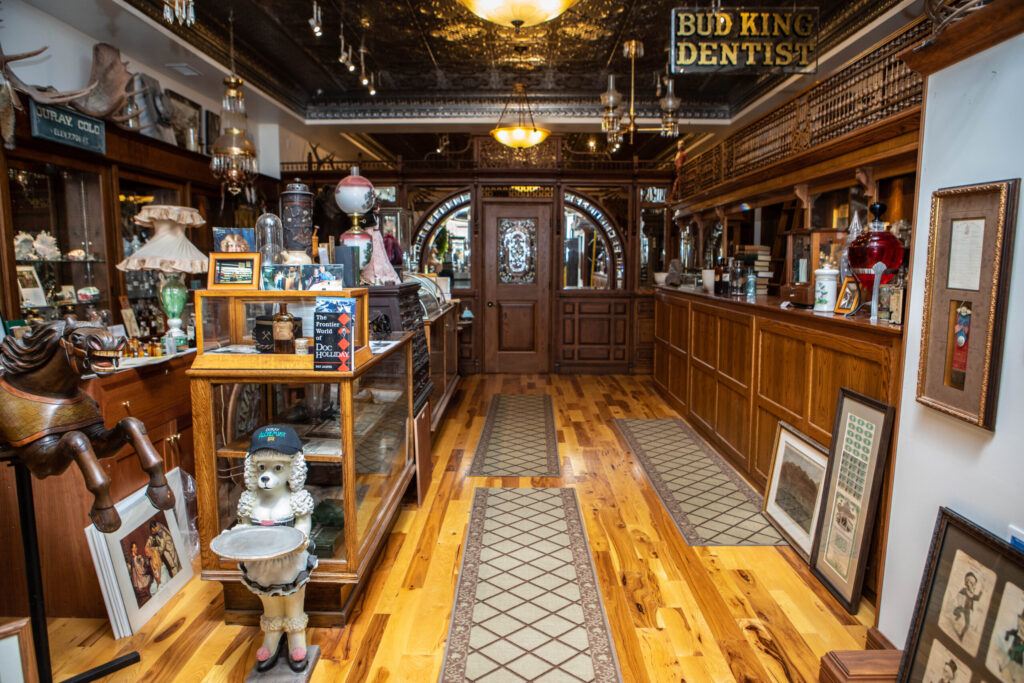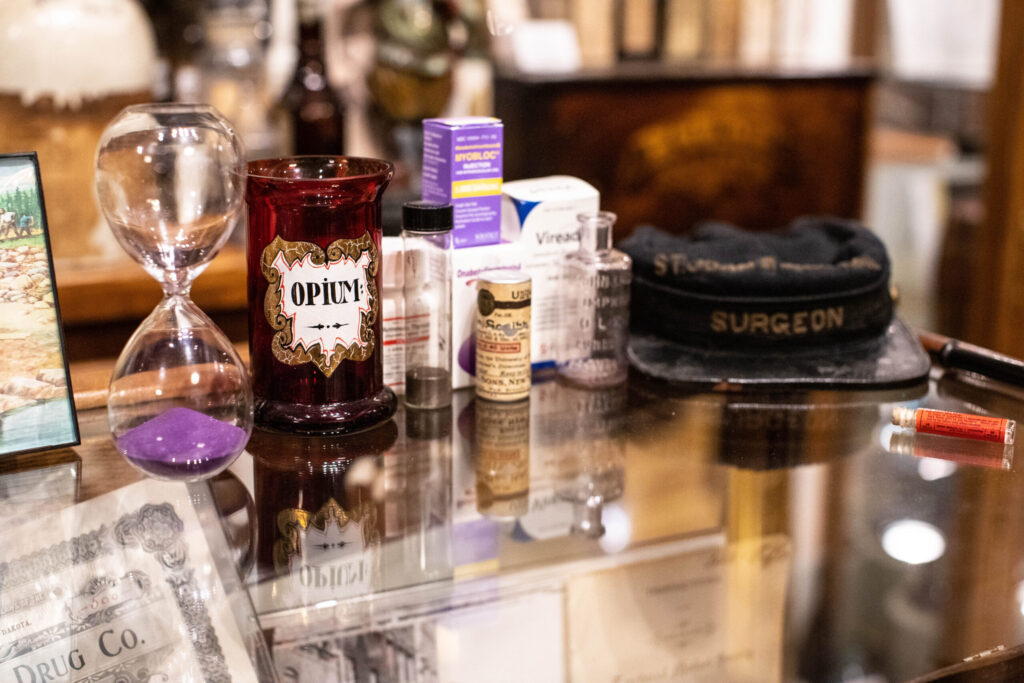
In the Ouray Alchemist, Colorado-based Nancy Haggar (BS ‘81) and her husband Curt operate a museum of rare pharmacy artifacts
By Katie Ginder-Vogel
In a small mountain town, the doors of a brick building, set off by show globes, escort you to a pharmacy in the early Wild West, complete with tin ceilings and wooden fixtures.
Designed to look like a frontier pharmacy from the 1800s, Ouray Alchemist, in Ouray, Colo., is a museum that includes a working soda fountain from 1893, the oldest prescription in Colorado, and over 700 hand-blown glass pharmacy bottles, many with the original drugs inside.
Ouray Alchemist is run by Nancy Losinski Haggar (BS ’81), and her husband Curt, both retired pharmacists. Curt has been retired since 2012, and Nancy retired just a year and a half ago, and they have both spent decades finding, refurbishing, and curating the special items in their collection of over 3,000 artifacts.
“We have an extensive historic collection of pharmacy and medical items, dating back as far as 200 B.C., but most items are from the 1800s, including many pieces from our local area in the San Juan Mountains,” says Nancy. “Dr. [Glenn] Sonnedecker would be proud! I took all of his history of pharmacy classes on topics like the history of psychoactive drugs, while working toward my pharmacy degree at the University of Wisconsin–Madison School of Pharmacy and found them fascinating.”
Building the collection
While her appreciation for pharmacy history — and how it illuminates the evolution of the field — stretches back to pharmacy school, Nancy’s involvement in collecting didn’t begin until she met her husband.
The two met while Nancy was still practicing as a pharmacist at Aspen Drug, where she worked for 11 years. She says she always knew she would end up in Colorado, even as a young girl, and a spring break ski trip she took to Summit County, Colo., in pharmacy school completely hooked her on the mountains.
“Aspen Drug really was like an old-time pharmacy in many ways,” Nancy says. “We did not have any pharmacy technicians, so the pharmacist was alone most of the time. There were many times when I worked open to close, 8 a.m. to 10 p.m., and brought breakfast, lunch, and dinner to eat while I was still working. We did not close for any breaks. However, I wouldn’t trade any of my experiences for the world.”

With the closure of Aspen Drug looming, the owner was looking to sell the interior fixtures, such as the shelves, doors, light fixtures, and countertops. Curt, who at the time had a budding collection of pharmacy memorabilia, was an interested buyer.
“He ended up buying all the working fixtures, as well as the historic pieces from 1888,” says Nancy. “I like to joke that I was thrown in with the deal.”
Curt’s interest in pharmacy history began when he graduated from the South Dakota State University College of Pharmacy in 1971 and went to work at a pharmacy in Denver, alongside five pharmacists who had been born in the late 19th century. They taught him some of the history of pharmacy in the Denver area.
“Pharmacists played a big part in everything,” he says. “They even acted as optometrists back then.”
His fascination with pharmacy artifacts took hold when a customer arrived at the pharmacy one day and asked him to refill a prescription, presenting him with a corked bottle. Curt’s preceptor at the pharmacy walked him through the process of refilling the prescription and showed him how to mix iodine crystals, glycerin, and the medication into a new bottle. Haggar was able to keep the cast-off old bottle, and as family members and friends learned about his interest in vintage prescription bottles, they began giving them to him as gifts. That was the beginning of a now-50-year-old collection.
Launching the museum
After Curt purchased the finishings from Aspen Drug, many of the pieces needed to be meticulously restored.
“I have always been interested in pharmacy history, so Curt’s collection did inspire me to become a part of the venture,” Nancy says. “I especially loved learning about how pharmacy was practiced in the Wild West.”

For example, there were no laws regulating pharmacy — doctors could buy a diploma for $50 and set up practice with little or no education. Most prescriptions were compounded into tinctures or rolled into pills.
“We have a pill roller from that time, which basically helped you roll the pills to a fairly uniform size manually,” says Nancy. “There were snake oil salesmen that traveled throughout the West, peddling ‘cures’ that were mainly alcohol. It was not illegal to call something a cure until the 1900s. Another interesting aspect was the adaptability of the pharmacists to come and go with the success of the town. Southern Colorado was filled with mining towns that had busts and booms.”
Ouray Alchemist is home to the oldest prescription in Colorado, which was written in 1867 in Denver and contained opium and camphor in a compounded form. Denver was founded in 1858 in Kansas territory, and Colorado became a state in 1876 — almost a decade after this prescription was written.
“We have the original paper hard copy,” says Nancy. “It would have been put in a glass bottle with a cork. We have a few cork presses, which were used to size the cork, and the pharmacist would put it in the bottle by hand. One that we have was made to look like an alligator, but they were also made in the shapes of dogs, snakes, or other animals.”
Even while Nancy continued to work a handful of pharmacy jobs until she retired, she designed the Ouray Alchemist website in her spare time, preparing to make their ambitions a reality, and traveled with Curt to add to the collection.
“It was fun finding additional pieces during buying trips to places like Missouri, Minnesota, and Denver,” she says. “We would pull a 20-foot trailer around with us.”
Most of the collection is from individual collectors and was acquired locally, from mining towns like Ouray and Telluride.
“Curt worked as a floating pharmacist for a number of years and would be sent to cover shifts all over Colorado, but mainly on the Western Slope,” says Nancy. “Often, he would see interesting historic ‘junk’ left out in yards and would knock on the door and see if they had anything appropriate to sell. With permission, he looked under many kitchen sinks to find old drug bottles.”
Curt joined a bottle club to make connections throughout the U.S., and in several cases, he was able to purchase old collections from families with connections to pharmacy of the past.
“There was no internet when my husband was doing this in the early years, well before the pickers on the History Channel,” says Nancy. “Now, we sometimes acquire a few unique and interesting things by going online.”
Curt stored the collection in storage lockers, and then in the Ouray home he and Nancy bought. When the Haggars had acquired enough pieces to fill a museum space, they decided to find a physical location for the collection and — at last — launch their museum.

“We considered having a working pharmacy but did not want to compete with another pharmacy that was just 10 miles from Ouray,” says Nancy. “We looked to purchase a building in Ouray that would accommodate all the fixtures, some of which were very large. Nothing would work, so we ended up buying a lot on Main Street in the heart of town and built our own building in 2010. We designed it to look like an old-fashioned pharmacy from the 1800s.”
“People can’t believe we designed the building, restored everything, and bought the drugstore fixtures — it’s a piece of art,” says Curt. “I picked up a soda fountain from 1893 and fully restored it to make sarsaparilla, which was once thought to cure tuberculosis and syphilis.”
A second soda fountain, from 1860, is in the second section of the museum, after visitors walk through the recreation of Aspen Drug, where visitors learn the steps pharmacists took to fill prescriptions in the 19th century. Then, they learn how to make soda.
Ouray Alchemist also sells non-prescription items, like toothbrushes and first aid items. The Haggars also answer questions from passersby who stop in to the museum for advice, often about altitude sickness, and display local artists’ work.
“It is fun to give advice to people who visit the museum or buy over-the-counter medicines,” says Nancy. “Since we aren’t filling prescriptions, we have plenty of time to fully evaluate a situation and recommend the best over-the-counter treatment.”
The golden years
Now that the couple is retired, they are dedicated to the museum full-time, offering tours every day and continuing to build the collection.
“Now, in my golden years, I’m searching for the weirder things,” Curt says. “I found ghost town bottles from Animas Forks — there’s nothing left of the town but buildings. The pharmacy was only there from 1880 until 1889, when the town burned down.”
The duo has no plans to slow down, actively building their collection and continuing to welcome curious locals and tourists.
“I consider myself very fortunate to have worked independent retail pharmacy for much of my career,” says Nancy. “And now, despite the fact that we are already at retirement age, we hope to continue showing the collection to folks and giving comprehensive tours and continuing to provoke interest in the field.”




















